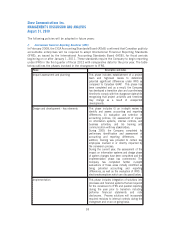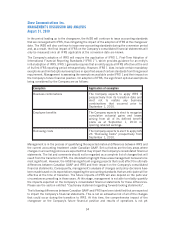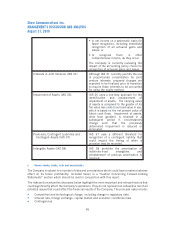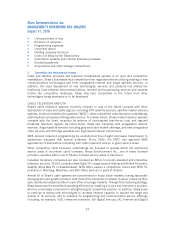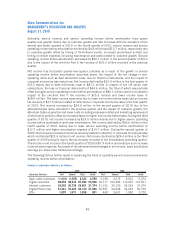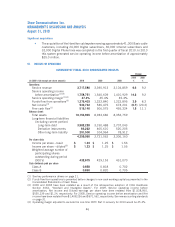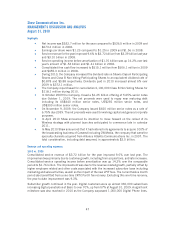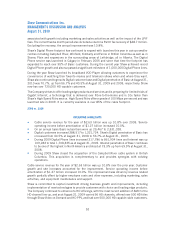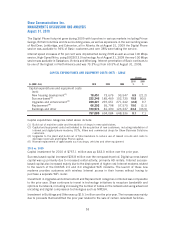Shaw 2010 Annual Report Download - page 47
Download and view the complete annual report
Please find page 47 of the 2010 Shaw annual report below. You can navigate through the pages in the report by either clicking on the pages listed below, or by using the keyword search tool below to find specific information within the annual report.vi) Programming expenses
Shaw’s programming expenses for Cable and DTH continue to be one of the most significant single
expense items. Costs for programming continue to increase, particularly for Sports programming. In
addition as the Company adds programming or distributes existing programming to more of the
subscriber base programming expenses increase. Although the Company has been successful at
reducing the impact of these increases through sale of additional services or increasing subscriber
rates, there can be no assurance that this will continue and operating results may be impacted.
In Media one of the most significant expenses is also programming costs. Increased competition in
the television broadcasting industry, developments affecting producers and distributors of
programming content, changes in viewer preferences and other developments could impact both
the availability and cost of programming content. Although the Corporation has processes to
effectively manage these costs, programming content may be purchased for broadcasting one to two
years in advance, making it more difficult to predict how such content will perform.
vii) Unionized labour
Approximately 50% of the Media division employees are unionized and are employed under a total
of 13 collective agreements represented by three bargaining units. If strikes, lock-outs or other
labour disruptions occur, it is possible that they may involve larger numbers of employees and
possibly cause a disruption to the Media business.
viii) Holding company structure
Substantially all of Shaw’s business activities are operated by its subsidiaries. As a holding
company, the Company’s ability to meet its financial obligations is dependent primarily upon
the receipt of interest and principal payments on intercompany advances, management fees, cash
dividends and other payments from its subsidiaries together with proceeds raised by the Company
through the issuance of equity and the incurrence of debt, and from proceeds received on the sale of
assets. The payment of dividends and the making of loans, advances and other payments to the
Company by its subsidiaries may be subject to statutory or contractual restrictions, are contingent
upon the earnings of those subsidiaries and are subject to various business and other
considerations.
ix) Control of Shaw by the Shaw family
As at October 31, 2010 JR Shaw and members of his family and the corporations owned and/or
controlled by JR Shaw and members of his family (the “JR Shaw Group”) own approximately 79% of
the outstanding Class A Shares of the Company. The Class A Shares are the only shares entitled to
vote in all shareholder matters. All of the Class A Shares held by the JR Shaw Group are subject to a
voting trust agreement entered into by such persons. The voting rights with respect to such Class A
Shares are exercised by the representative of a committee of five trustees. Accordingly, the JR Shaw
Group is, and as long as it owns a majority of the Class A Shares will continue to be, able to elect a
majority of the Board of Directors of the Company and to control the vote on matters submitted to a
vote of the Company’s Class A shareholders.
x) Information systems and internal business processes
Many aspects of the Company’s business depend to a large extent on various IT systems and
software and internal business processes. The Company is subject to risk as a result of potential
failures of, or deficiencies in, these systems or processes. Although the Company has taken steps to
reduce this risk, there can be no assurance that losses may not occur.
43
Shaw Communications Inc.
MANAGEMENT’S DISCUSSION AND ANALYSIS
August 31, 2010


